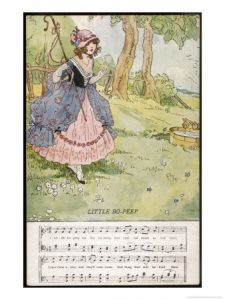
1. Origins
Parents and children have enjoyed nursery rhymes throughout history. The first version of Little Bo Peep was found in 1805 England and had one line of verse. Some historians relate the story to biblical meaning because of its theme of flocks of sheep with parables of Jesus. Others reference records of Bo Peep from Shakespeare‘s King Lear speaking of a children’s game of peek-a-boo. There is also knowledge of an English custom’s house named Bo Peep. Regardless of its uncertain roots, there is no doubt the poem has brought much happiness and wisdom to adults and children with its colorful characters and valuable lessons.
2. Story
Like many other preschool songs; there are many variations passed on through the years. A youthful, beautiful shepherdess is tending to her sheep and unfortunately fell asleep while sitting to rest under a tree. She is awoken by what appears to be a wiser, older woman asking her where the sheep are grazing. She is alarmed by her presence and enters into a conversation about her knowledge of shepherding and how she knows everything about the animals from experience. The older woman surprisingly tells Little Bo Peep not to worry; they will return on their own. They did not return, so she wandered over the meadow and found the sheep had lost their tails and were hanging to dry on a tree. The shepherdess then tries to give the sheep back their tails in the extended version of the rhyme.
3. Modern Renditions
Toy Story featured a porcelain character modeled after Bo Peep. Annie Potts was the famous voice behind the character as Woody’s romantic tryst. The character was eventually written out of the third series as the toy lost interest over time. Sesame Studios also produced many entertaining videos about the rhyme available on youtube for children and parents to enjoy together. If you search for this nursery poem across the internet, you will find many variations of the famous poem. Modern looking characters, brilliant color animation, well-known voices and movie clips all combine with educational material to relate to one of the first poems all children learn by heart. These beautiful songs warm our childhood because they help us read through pronunciation, syllables, colors and meaningful lessons for behavior.
4. Morale of the Story
Mother Goose nursery rhymes do not all have a morale as most are used to learn speech, reading and relate every day life situations together as a young group or family. Bo Peep learns she has to be more careful as a shepherdess when she falls asleep and leaves them unattended. She also has to pay the consequences in one version and mend her sheeps tails. The morale teaches pre-school age to make sure you get enough sleep at night, for if you doze off, you will have to fix what happened while you were not awake. This is a valuable lesson in responsibility and one we all remember throughout our lives. There is also great emphasis on the importance of caring for animals. Children learn early in life that pets depend on humans for food, protection, health,and affection. This teaches them obligation and commitment to pet care for a lifetime of enjoyment as our little furry friends. Parents and teachers will always turn to beloved rhymes and rhythms to begin childhood in a fun, colorful and amazing way. How we teach them is our gift to them, and how they learn and respond is their gift to us.